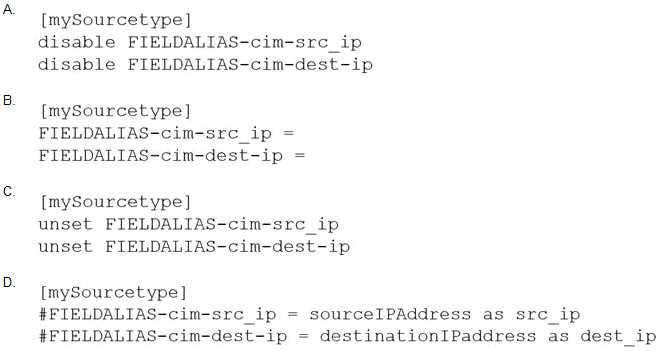my answer is C
Which data pipeline phase is the last opportunity for defining event boundaries?
C
Explanation:
Reference
https://docs.splunk.com/Documentation/Splunk/8.2.3/Admin/Configurationparametersandthedatap
ipeline
Which of the following Splunk components require a separate installation package?
C
Explanation:
Reference:
https://github.com/packetiq/SplunkArchitect/blob/master/Install-and-Configure-Splunk-
Enterprise-Components.md
my answer is C
Which forwarder is recommended by Splunk to use in a production environment?
D
Explanation:
Reference:
https://community.splunk.com/t5/Getting-Data-In/Splunk-forwarder/m-p/18009
my answer is A
An add-on has configured field aliases for source IP address and destination IP address fields. A
specific user prefers not to have those fields present in their user context. Based on the default
props.conf below, which SPLUNK_HOME/etc/users/buttercup/myTA/local/props.conf stanza can be
added to the users local context to disable the field aliases?

B
my answer is B
When using license pools, volume allocations apply to which Splunk components?
A
Explanation:
Reference:
https://docs.splunk.com/Documentation/Splunk/8.2.3/Admin/Groups,stacks,pools,andothertermino
logy
my answer is A
When using a directory monitor input, specific source type can be selectively overridden using which
configuration file?
A
Explanation:
Reference:
https://docs.splunk.com/Documentation/SplunkCloud/latest/Data/Bypassautomaticsourcetypeassig
nment
my answer is A
A new forwarder has been installed with a manually created deploymentclient.conf.
What is the next step to enable the communication between the forwarder and the deployment
server?
A
Explanation:
Reference:
https://docs.splunk.com/Documentation/Forwarder/8.2.3/Forwarder/Configuretheuniversalforward
er
Which network input option provides durable file-system buffering of data to mitigate data loss due
to network outages and splunkd restarts?
C
Explanation:
Reference:
https://docs.splunk.com/Documentation/SplunkCloud/8.2.2111/Data/Usepersistentqueues
Which of the following are reasons to create separate indexes? (Choose all that apply.)
AD
Explanation:
Reference:
https://community.splunk.com/t5/Getting-Data-In/Why-does-Splunk-have-multiple-
indexes/m-p/12063
In this example, if useACK is set to true and the maxQueueSize is set to 7MB, what is the size of the
wait queue on this universal forwarder?
A
Explanation:
Reference:
https://docs.splunk.com/Documentation/SplunkCloud/latest/Forwarding/Protectagainstlossofin-
flightdata
Which setting allows the configuration of Splunk to allow events to span over more than one line?
C
Explanation:
Reference:
https://docs.splunk.com/Documentation/SplunkCloud/latest/Data/Configureeventlinebreaking
What is the command to reset the fishbucket for one source?
C
Explanation:
Reference:
https://community.splunk.com/t5/Getting-Data-In/How-can-I-trigger-the-re-indexing-of-
a-single-file/m-p/108568
In addition to single, non-clustered Splunk instances, what else can the deployment server push apps
to?
A
Explanation:
Reference:
https://community.splunk.com/t5/Deployment-Architecture/Push-apps-from-
deployment-server-automatically-to-universal/m-p/328191
All search-time field extractions should be specified on which Splunk component?
C
Explanation:
Reference:
https://github.com/packetiq/SplunkArchitect/blob/master/README/props.conf.spec
Which artifact is required in the request header when creating an HTTP event?
B
Explanation:
Reference:
https://docs.splunk.com/Documentation/Splunk/8.2.3/Data/FormateventsforHTTPEventCollector
my answer is C